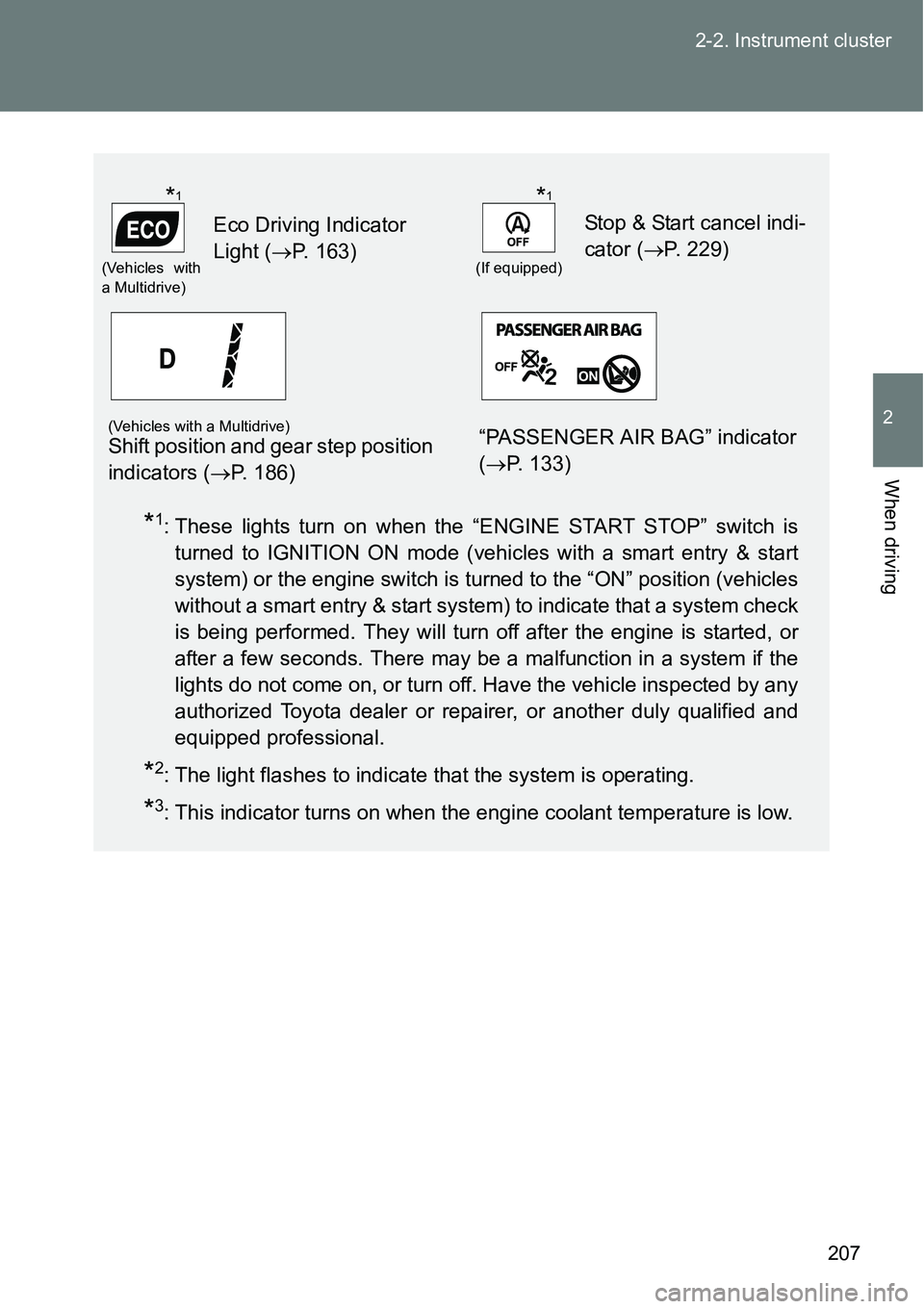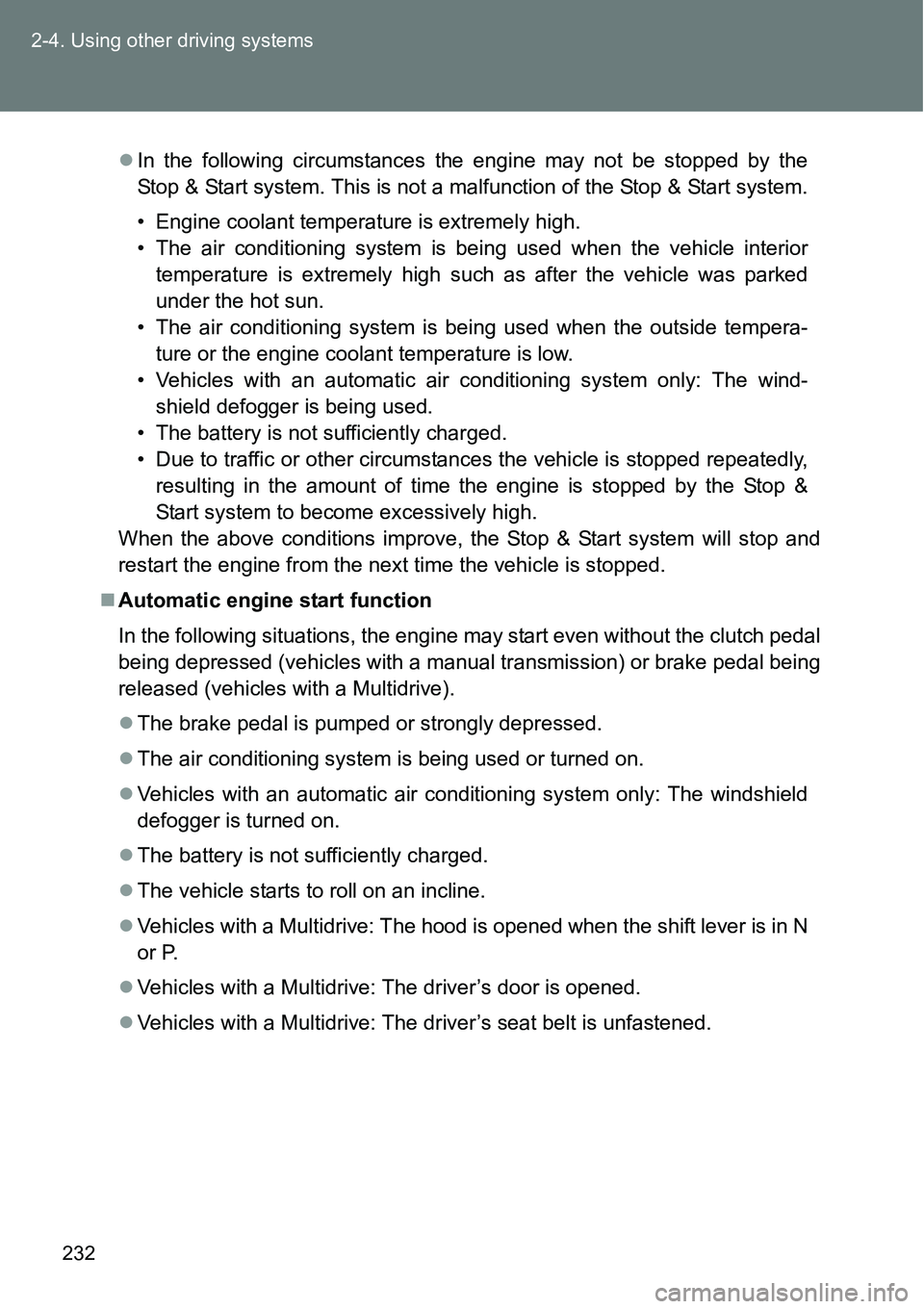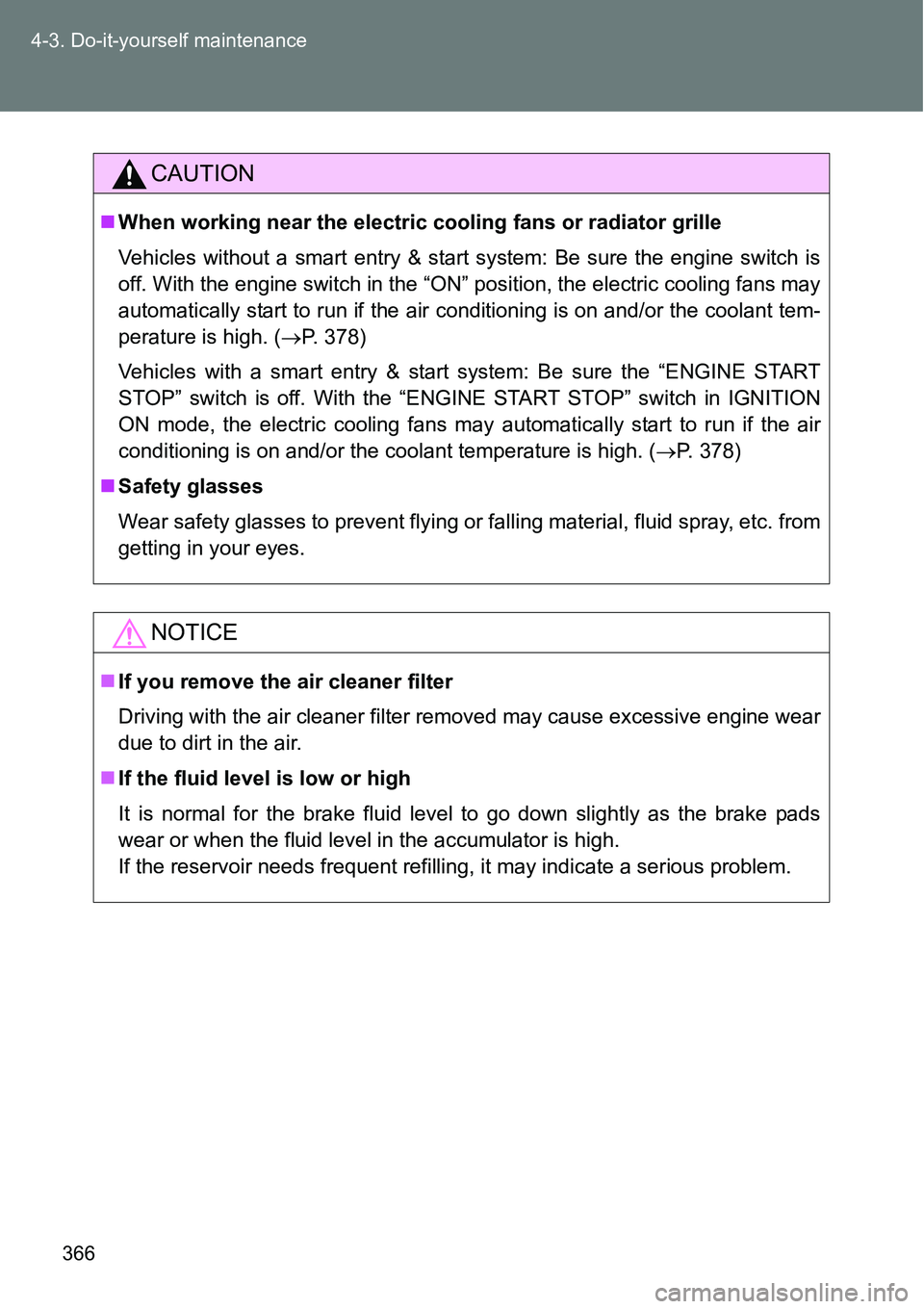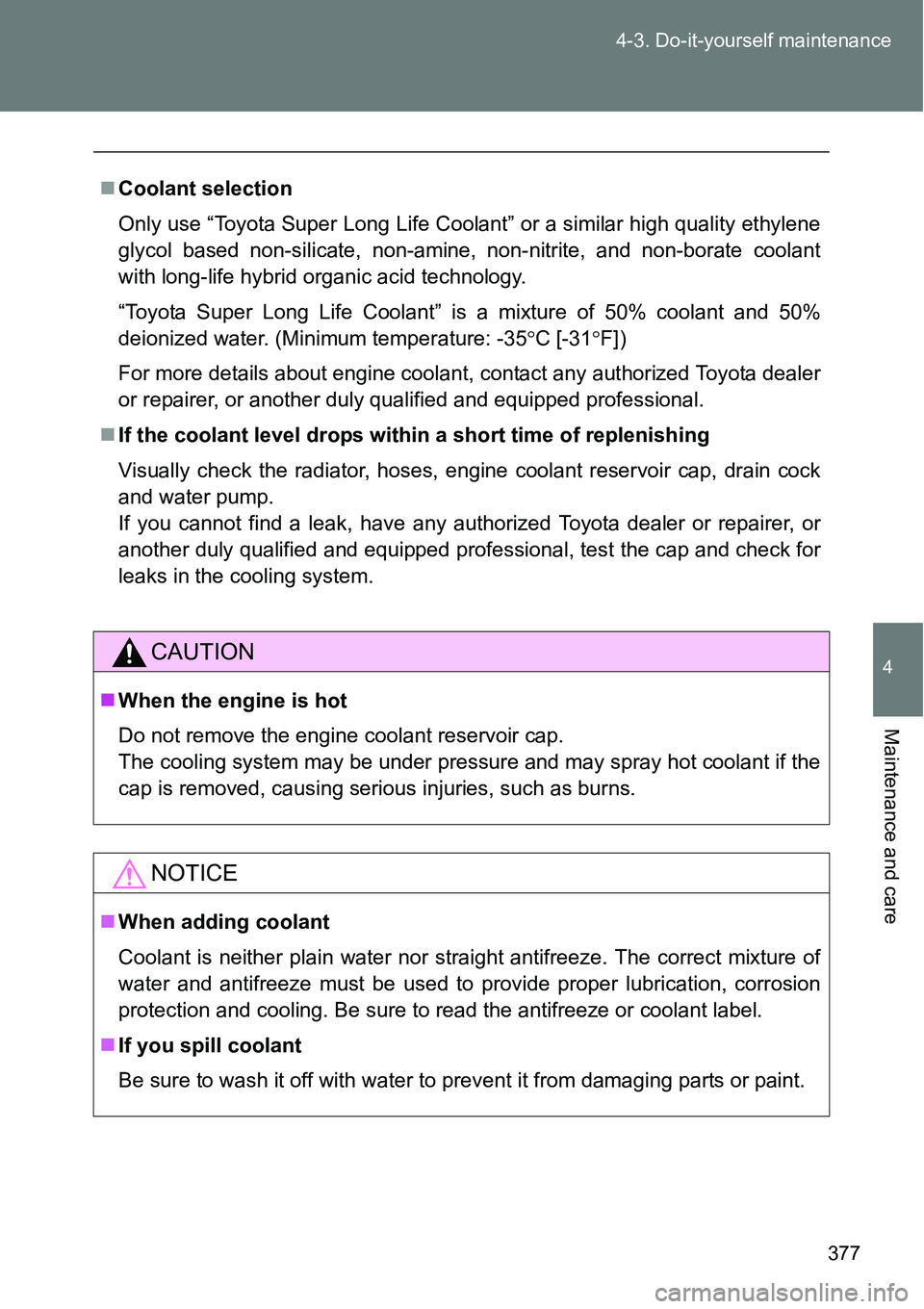Page 203 of 564
203 2-2. Instrument cluster
2
When driving
NOTICE
To prevent damage to the engine and its components
Do not let the indicator needle of the tachometer enter the red zone, which
indicates the maximum engine speed.
The engine may be overheating if the high engine coolant temperature
warning light flashes or turns on. In this case, immediately stop the vehicle
in a safe place, and check the engine after it has cooled completely.
(
P. 509)
Page 206 of 564
206 2-2. Instrument cluster
Indicators
The indicators inform the driver of the operating state of the
vehicle’s various systems.
Turn signal indicator
(P. 195)
(Vehicles with
a manual
transmission)
Gear Shift Indicator
(P. 193)
Headlight high beam
indicator (P. 214)
(Diesel engine)
Engine preheating
indicator (P. 173, 182)
(If equipped)
Tail light indicator
(P. 213)
(Green)
(If equipped)
Cruise control indicator
(P. 236)
(If equipped)
Front fog light indicator
(P. 219)
(If equipped)
Cruise control set indi-
cator (P. 236)
Rear fog light indicator
(P. 219)VSC OFF indicator
(P. 241)
(If equipped)
Smart entry & start sys-
tem indicator (P. 173)“TRC OFF” indicator
(P. 241)
(If equipped)
Stop & Start indicator
(P. 229)
(Vehicles with
a Multidrive)
“SPORT” indicator
(P. 187)
Engine immobilizer/
alarm system indicator
(P. 105)Slip indicator
(P. 241)
(Blue)
Low engine coolant
temperature indicator
*1
*1
*1
*1
*1, 2
*3
Page 207 of 564

207 2-2. Instrument cluster
2
When driving
*1: These lights turn on when the “ENGINE START STOP” switch is
turned to IGNITION ON mode (vehicles with a smart entry & start
system) or the engine switch is turned to the “ON” position (vehicles
without a smart entry & start system) to indicate that a system check
is being performed. They will turn off after the engine is started, or
after a few seconds. There may be a malfunction in a system if the
lights do not come on, or turn off. Have the vehicle inspected by any
authorized Toyota dealer or repairer, or another duly qualified and
equipped professional.
*2: The light flashes to indicate that the system is operating.
*3: This indicator turns on when the engine coolant temperature is low.
(Vehicles with
a Multidrive)
Eco Driving Indicator
Light (P. 163)
(If equipped)
Stop & Start cancel indi-
cator (P. 229)
(Vehicles with a Multidrive)Shift position and gear step position
indicators (P. 186)“PASSENGER AIR BAG” indicator
(P. 133)
*1*1
Page 232 of 564

232 2-4. Using other driving systems
In the following circumstances the engine may not be stopped by the
Stop & Start system. This is not a malfunction of the Stop & Start system.
• Engine coolant temperature is extremely high.
• The air conditioning system is being used when the vehicle interior
temperature is extremely high such as after the vehicle was parked
under the hot sun.
• The air conditioning system is being used when the outside tempera-
ture or the engine coolant temperature is low.
• Vehicles with an automatic air conditioning system only: The wind-
shield defogger is being used.
• The battery is not sufficiently charged.
• Due to traffic or other circumstances the vehicle is stopped repeatedly,
resulting in the amount of time the engine is stopped by the Stop &
Start system to become excessively high.
When the above conditions improve, the Stop & Start system will stop and
restart the engine from the next time the vehicle is stopped.
Automatic engine start function
In the following situations, the engine may start even without the clutch pedal
being depressed (vehicles with a manual transmission) or brake pedal being
released (vehicles with a Multidrive).
The brake pedal is pumped or strongly depressed.
The air conditioning system is being used or turned on.
Vehicles with an automatic air conditioning system only: The windshield
defogger is turned on.
The battery is not sufficiently charged.
The vehicle starts to roll on an incline.
Vehicles with a Multidrive: The hood is opened when the shift lever is in N
or P.
Vehicles with a Multidrive: The driver’s door is opened.
Vehicles with a Multidrive: The driver’s seat belt is unfastened.
Page 262 of 564
262 2-5. Driving information
Transmission information
Vehicles with a Multidrive
Select an appropriate gear in M mode to maintain the effectiveness
of engine braking and to maintain charging system performance.
Vehicles with a manual transmission
Refrain from driving in 6th gear to maintain the effectiveness of
engine braking and to maintain charging system performance.
If the engine overheats
Towing a loaded trailer up a long, steep incline in temperatures
exceeding 30C (85F) may result in the engine overheating. If the
high engine coolant temperature warning light flashes or comes
on, turn the air conditioning off immediately, leave the road and
stop the vehicle in a safe place. (P. 509)
When parking the vehicle
Always place wheel chocks under the wheels of both the vehicle
and trailer. Firmly set the parking brake and shift the shift lever to P
for Multidrives and 1 or R for manual transmissions.
Page 363 of 564
363 4-2. Maintenance
4
Maintenance and care
Engine coolant temperature continually higher than normal
If you notice any of these clues, take your vehicle to any authorized Toyota
dealer or repairer, or another duly qualified and equipped professional as
soon as possible. Your vehicle may need adjustment or repair.
CAUTION
If your vehicle is not properly maintained
Improper maintenance could result in serious damage to the vehicle and
possible serious injury or death.
Handling of the battery
Battery posts, terminals and related accessories contain lead and lead com-
pounds which are known to cause brain damage. Wash your hands after
handling. (P. 378)
Page 366 of 564

366 4-3. Do-it-yourself maintenance
CAUTION
When working near the electric cooling fans or radiator grille
Vehicles without a smart entry & start system: Be sure the engine switch is
off. With the engine switch in the “ON” position, the electric cooling fans may
automatically start to run if the air conditioning is on and/or the coolant tem-
perature is high. (P. 378)
Vehicles with a smart entry & start system: Be sure the “ENGINE START
STOP” switch is off. With the “ENGINE START STOP” switch in IGNITION
ON mode, the electric cooling fans may automatically start to run if the air
conditioning is on and/or the coolant temperature is high. (P. 378)
Safety glasses
Wear safety glasses to prevent flying or falling material, fluid spray, etc. from
getting in your eyes.
NOTICE
If you remove the air cleaner filter
Driving with the air cleaner filter removed may cause excessive engine wear
due to dirt in the air.
If the fluid level is low or high
It is normal for the brake fluid level to go down slightly as the brake pads
wear or when the fluid level in the accumulator is high.
If the reservoir needs frequent refilling, it may indicate a serious problem.
Page 377 of 564

377 4-3. Do-it-yourself maintenance
4
Maintenance and care
Coolant selection
Only use “Toyota Super Long Life Coolant” or a similar high quality ethylene
glycol based non-silicate, non-amine, non-nitrite, and non-borate coolant
with long-life hybrid organic acid technology.
“Toyota Super Long Life Coolant” is a mixture of 50% coolant and 50%
deionized water. (Minimum temperature: -35C [-31F])
For more details about engine coolant, contact any authorized Toyota dealer
or repairer, or another duly qualified and equipped professional.
If the coolant level drops within a short time of replenishing
Visually check the radiator, hoses, engine coolant reservoir cap, drain cock
and water pump.
If you cannot find a leak, have any authorized Toyota dealer or repairer, or
another duly qualified and equipped professional, test the cap and check for
leaks in the cooling system.
CAUTION
When the engine is hot
Do not remove the engine coolant reservoir cap.
The cooling system may be under pressure and may spray hot coolant if the
cap is removed, causing serious injuries, such as burns.
NOTICE
When adding coolant
Coolant is neither plain water nor straight antifreeze. The correct mixture of
water and antifreeze must be used to provide proper lubrication, corrosion
protection and cooling. Be sure to read the antifreeze or coolant label.
If you spill coolant
Be sure to wash it off with water to prevent it from damaging parts or paint.